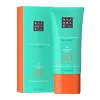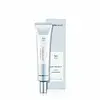What's inside
What's inside
 Key Ingredients
Key Ingredients

 Benefits
Benefits

 Concerns
Concerns

 Ingredients Side-by-side
Ingredients Side-by-side

Water
Skin ConditioningC12-15 Alkyl Benzoate
AntimicrobialGlycerin
HumectantIsopropyl Palmitate
EmollientButyl Methoxydibenzoylmethane
UV AbsorberEthylhexyl Salicylate
UV AbsorberBis-Ethylhexyloxyphenol Methoxyphenyl Triazine
Skin ConditioningEthylhexyl Triazone
UV AbsorberCetearyl Alcohol
EmollientPotassium Cetyl Phosphate
EmulsifyingTocopheryl Acetate
AntioxidantNelumbo Nucifera Flower Extract
Skin ConditioningCamellia Sinensis Leaf Extract
AntimicrobialNannochloropsis Oculata Extract
HumectantPorphyra Umbilicalis Extract
Skin ConditioningAloe Barbadensis Leaf Extract
EmollientSilybum Marianum Seed Oil
Skin ConditioningSqualane
EmollientParfum
MaskingDiethylhexyl Butamido Triazone
UV AbsorberGlyceryl Stearate
EmollientXanthan Gum
EmulsifyingPhenylbenzimidazole Sulfonic Acid
UV AbsorberPolyglyceryl-2 Dipolyhydroxystearate
Skin ConditioningAcacia Senegal Gum
MaskingAspartic Acid
MaskingAlcohol
AntimicrobialCaprylyl Glycol
EmollientCaprylhydroxamic Acid
Benzyl Alcohol
PerfumingBenzyl Salicylate
PerfumingLimonene
PerfumingLinalool
PerfumingHexyl Cinnamal
PerfumingAlpha-Isomethyl Ionone
PerfumingCitronellol
PerfumingCitral
PerfumingAminomethyl Propanol
BufferingTetrasodium Iminodisuccinate
Fumaric Acid
BufferingMaleic Acid
BufferingMalic Acid
BufferingWater, C12-15 Alkyl Benzoate, Glycerin, Isopropyl Palmitate, Butyl Methoxydibenzoylmethane, Ethylhexyl Salicylate, Bis-Ethylhexyloxyphenol Methoxyphenyl Triazine, Ethylhexyl Triazone, Cetearyl Alcohol, Potassium Cetyl Phosphate, Tocopheryl Acetate, Nelumbo Nucifera Flower Extract, Camellia Sinensis Leaf Extract, Nannochloropsis Oculata Extract, Porphyra Umbilicalis Extract, Aloe Barbadensis Leaf Extract, Silybum Marianum Seed Oil, Squalane, Parfum, Diethylhexyl Butamido Triazone, Glyceryl Stearate, Xanthan Gum, Phenylbenzimidazole Sulfonic Acid, Polyglyceryl-2 Dipolyhydroxystearate, Acacia Senegal Gum, Aspartic Acid, Alcohol, Caprylyl Glycol, Caprylhydroxamic Acid, Benzyl Alcohol, Benzyl Salicylate, Limonene, Linalool, Hexyl Cinnamal, Alpha-Isomethyl Ionone, Citronellol, Citral, Aminomethyl Propanol, Tetrasodium Iminodisuccinate, Fumaric Acid, Maleic Acid, Malic Acid
Water
Skin ConditioningEthylhexyl Methoxycinnamate
UV AbsorberHomosalate
Skin ConditioningEthylhexyl Salicylate
UV AbsorberDiethylamino Hydroxybenzoyl Hexyl Benzoate
UV FilterButylene Glycol
HumectantOctocrylene
UV AbsorberDicaprylyl Carbonate
EmollientCyclopentasiloxane
EmollientC20-22 Alkyl Phosphate
EmulsifyingC20-22 Alcohols
Emulsion StabilisingSilica
Abrasive1,2-Hexanediol
Skin ConditioningPortulaca Oleracea Extract
Skin ConditioningNelumbo Nucifera Flower Water
TonicGlycine Soja Lipids
Skin ConditioningEchium Plantagineum Seed Oil
Skin ConditioningAloe Barbadensis Leaf Extract
EmollientAlthaea Rosea Flower Extract
Skin ConditioningCardiospermum Halicacabum Flower/Leaf/Vine Extract
Skin ConditioningHelianthus Annuus Seed Oil Unsaponifiables
EmollientPlukenetia Volubilis Seed Oil
EmollientCetyl Alcohol
EmollientGlyceryl Stearate
EmollientGlycerin
HumectantTromethamine
BufferingPolyacrylate Crosspolymer-6
Emulsion StabilisingOctyldodecanol
EmollientGlyceryl Caprylate
EmollientCaprylyl Glycol
EmollientMicrocrystalline Cellulose
AbsorbentXanthan Gum
EmulsifyingSodium Acrylate/Sodium Acryloyldimethyl Taurate Copolymer
Emulsion StabilisingPolyisobutene
Ethylhexylglycerin
Skin ConditioningGlyceryl Polymethacrylate
Cellulose Gum
Emulsion StabilisingSorbitan Oleate
EmulsifyingCaprylyl/Capryl Glucoside
CleansingParfum
MaskingWater, Ethylhexyl Methoxycinnamate, Homosalate, Ethylhexyl Salicylate, Diethylamino Hydroxybenzoyl Hexyl Benzoate, Butylene Glycol, Octocrylene, Dicaprylyl Carbonate, Cyclopentasiloxane, C20-22 Alkyl Phosphate, C20-22 Alcohols, Silica, 1,2-Hexanediol, Portulaca Oleracea Extract, Nelumbo Nucifera Flower Water, Glycine Soja Lipids, Echium Plantagineum Seed Oil, Aloe Barbadensis Leaf Extract, Althaea Rosea Flower Extract, Cardiospermum Halicacabum Flower/Leaf/Vine Extract, Helianthus Annuus Seed Oil Unsaponifiables, Plukenetia Volubilis Seed Oil, Cetyl Alcohol, Glyceryl Stearate, Glycerin, Tromethamine, Polyacrylate Crosspolymer-6, Octyldodecanol, Glyceryl Caprylate, Caprylyl Glycol, Microcrystalline Cellulose, Xanthan Gum, Sodium Acrylate/Sodium Acryloyldimethyl Taurate Copolymer, Polyisobutene, Ethylhexylglycerin, Glyceryl Polymethacrylate, Cellulose Gum, Sorbitan Oleate, Caprylyl/Capryl Glucoside, Parfum
 Reviews
Reviews

Ingredients Explained
These ingredients are found in both products.
Ingredients higher up in an ingredient list are typically present in a larger amount.
Aloe Barbadensis Leaf Extract is an extract of the leaves of the aloe, Aloe barbadensis, Liliaceae.
Aloe is one of the most well-known natural soothing ingredients, and for good reason. It’s full of water and has a cooling, calming effect on the skin, especially when it’s sunburned, itchy, or irritated. Aloe also helps your skin stay hydrated and smooth by mimicking what healthy skin naturally produces. On top of that, it contains vitamins and nutrients that support skin recovery.
It doesn’t protect you from the sun, but it can help your skin bounce back after too much time in it.
Let’s get into the details:
Aloe contains antioxidant Vitamins A, C, and E, which help fight off free radicals (unstable molecules from things like pollution that can damage your skin).
It’s also rich in polysaccharides, which are natural sugars that help hydrate the skin by acting like the skin’s own moisturizing agents. These, along with other sugars like monosaccharides, help form a protective barrier that locks in moisture.
Aloe works as both a humectant and an emollient. That means it draws water into the skin (humectant) and helps trap it there (emollient), making it an effective natural moisturizer.
You’ll also find a mix of other skin-supporting ingredients in aloe, including folic acid, choline, calcium, amino acids, fatty acids, and even Vitamin B12.
Out of the 420+ species of aloe, Aloe barbadensis is the most widely used in skincare products thanks to its gentle yet effective properties.
There are over 420 species of aloe but Aloe Barbadensis is the most commonly used for topical products.
Learn more about Aloe Barbadensis Leaf ExtractCaprylyl Glycol is a humectant and emollient, meaning it attracts and preserves moisture.
It is a common ingredient in many products, especially those designed to hydrate skin. The primary benefits are retaining moisture, skin softening, and promoting a healthy skin barrier.
Though Caprylyl Glycol is an alcohol derived from fatty acids, it is not the kind that can dry out skin.
This ingredient is also used as a preservative to extend the life of products. It has slight antimicrobial properties.
Learn more about Caprylyl GlycolEthylhexyl Salicylate is an organic compound used to block UV rays. It primarily absorbs UVB rays but offers a small amount of UVA protection as well.
Commonly found in sunscreens, Ethylhexyl Salicylate is created from salicylic acid and 2-ethylhexanol. You might know salicylic acid as the effective acne fighter ingredient and BHA.
The ethylhexanol in this ingredient is a fatty alcohol and helps hydrate your skin, similar to oils. It is an emollient, which means it traps moisture into the skin.
According to manufacturers, Ethylhexyl Salicylate absorbs UV wavelength of 295-315 nm, with a peak absorption at 307-310 nm. UVA rays are linked to long term skin damage, such as hyperpigmentation. UVB rays emit more energy and are capable of damaging our DNA. UVB rays cause sunburn.
Learn more about Ethylhexyl SalicylateGlycerin is already naturally found in your skin. It helps moisturize and protect your skin.
A study from 2016 found glycerin to be more effective as a humectant than AHAs and hyaluronic acid.
As a humectant, it helps the skin stay hydrated by pulling moisture to your skin. The low molecular weight of glycerin allows it to pull moisture into the deeper layers of your skin.
Hydrated skin improves your skin barrier; Your skin barrier helps protect against irritants and bacteria.
Glycerin has also been found to have antimicrobial and antiviral properties. Due to these properties, glycerin is often used in wound and burn treatments.
In cosmetics, glycerin is usually derived from plants such as soybean or palm. However, it can also be sourced from animals, such as tallow or animal fat.
This ingredient is organic, colorless, odorless, and non-toxic.
Glycerin is the name for this ingredient in American English. British English uses Glycerol/Glycerine.
Learn more about GlycerinGlyceryl Stearate is a mix of glycerin and stearic acid.
It is used to stabilize the mixing of water and oil ingredients. By preventing these ingredients from separating, it can help elongate shelf life. It can also help thicken the product's texture.
As an emollient, it helps soften skin and supports barrier-replenishing ingredients.
In cosmetics, Glyceryl Stearate is often made from vegetable oils or synthetically produced.
This ingredient may not be fungal-acne safe
Fun fact: The human body also creates Glyceryl Stearate naturally.
Learn more about Glyceryl StearateParfum is a catch-all term for an ingredient or more that is used to give a scent to products.
Also called "fragrance", this ingredient can be a blend of hundreds of chemicals or plant oils. This means every product with "fragrance" or "parfum" in the ingredients list is a different mixture.
For instance, Habanolide is a proprietary trade name for a specific aroma chemical. When used as a fragrance ingredient in cosmetics, most aroma chemicals fall under the broad labeling category of “FRAGRANCE” or “PARFUM” according to EU and US regulations.
The term 'parfum' or 'fragrance' is not regulated in many countries. In many cases, it is up to the brand to define this term.
For instance, many brands choose to label themselves as "fragrance-free" because they are not using synthetic fragrances. However, their products may still contain ingredients such as essential oils that are considered a fragrance by INCI standards.
One example is Calendula flower extract. Calendula is an essential oil that still imparts a scent or 'fragrance'.
Depending on the blend, the ingredients in the mixture can cause allergies and sensitivities on the skin. Some ingredients that are known EU allergens include linalool and citronellol.
Parfum can also be used to mask or cover an unpleasant scent.
The bottom line is: not all fragrances/parfum/ingredients are created equally. If you are worried about fragrances, we recommend taking a closer look at an ingredient. And of course, we always recommend speaking with a professional.
Learn more about ParfumWater. It's the most common cosmetic ingredient of all. You'll usually see it at the top of ingredient lists, meaning that it makes up the largest part of the product.
So why is it so popular? Water most often acts as a solvent - this means that it helps dissolve other ingredients into the formulation.
You'll also recognize water as that liquid we all need to stay alive. If you see this, drink a glass of water. Stay hydrated!
Learn more about WaterXanthan gum is used as a stabilizer and thickener within cosmetic products. It helps give products a sticky, thick feeling - preventing them from being too runny.
On the technical side of things, xanthan gum is a polysaccharide - a combination consisting of multiple sugar molecules bonded together.
Xanthan gum is a pretty common and great ingredient. It is a natural, non-toxic, non-irritating ingredient that is also commonly used in food products.
Learn more about Xanthan Gum